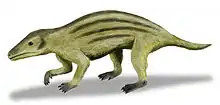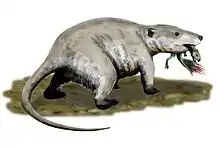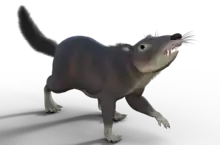Steropodon
Steropodon galmani is a prehistoric species of monotreme, or egg-laying mammal, that lived about 105 million years ago (mya) in the Late Cretaceous period. It is one of the oldest monotremes discovered, and is one of the oldest Australian mammal discoveries.
| Steropodon | |
|---|---|
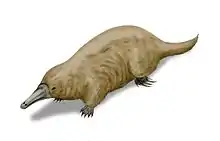 | |
| Scientific classification | |
| Kingdom: | Animalia |
| Phylum: | Chordata |
| Class: | Mammalia |
| Order: | Monotremata |
| Family: | †Steropodontidae |
| Genus: | †Steropodon Archer, Flannery, Ritchie, & Molnar, 1985 |
| Species: | †S. galmani |
| Binomial name | |
| †Steropodon galmani | |
Taxonomy

The dentition of Steropodon is somewhat similar to that of therians—the placentals and the marsupials—specifically the presence of the tribosphenic molar tooth which was thought to be exclusive to therians since the Cretaceous. This, along with the tribosphenic molar discoveries of monotreme-relatives Ausktribosphenos and Ambondro mahabo of which the latter evolved in the Jurassic, led to the conclusion that the molar evolved independently in the two lineages. This inspired the creation of the subclasses Australosphenida—the monotremes and extinct relatives—and Tribosphenida—placentals and marsupials. However, given this classification is based only on jaw and lower-tooth remains, insufficient evidence may exist to definitively make this conclusion.[2]
The specific epithet is derived from the surname of the jaw's collectors, when combined with the genus name Steropodon is intended to translate as "Galman's lightning tooth".[3]
Description
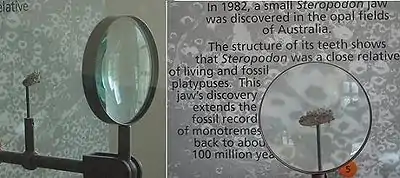
Steropodon is known only from a single opalised jaw with three molars, discovered at the Griman Creek Formation, Lightning Ridge, New South Wales, Australia, by brothers David and Alan Galman. It was a large mammal for the Mesozoic, being 40–50 centimetres (16–20 in) long. The lower molars are 5–7 millimetres (0.20–0.28 in) in length, with a width of 3–4 millimetres (0.12–0.16 in). A length of 1–2 centimetres (0.39–0.79 in) is more typical for Mesozoic mammals.[4]
Woodburne (2003, p. 212) reports that the holotype is a right mandible named AM F66763. The preserved molars are m1–m3. Examination of the jaw fragment revealed a mandibular canal, which has been proposed to indicate the presence of a bill, similar to those of the extinct species Obdurodon dicksoni and the modern platypus Ornithorhynchus anatinus.
See also
References
- Bell, Phil R.; Fanti, Federico; Hart, Lachlan J.; Milan, Luke A.; Craven, Stephen J.; Brougham, Thomas; Smith, Elizabeth (2019). "Revised geology, age, and vertebrate diversity of the dinosaur-bearing Griman Creek Formation (Cenomanian), Lightning Ridge, New South Wales, Australia". Palaeogeography, Palaeoclimatology, Palaeoecology. 514: 655–671. doi:10.1016/j.palaeo.2018.11.020.
- Stokstad, E. (2001). "Tooth theory revises history of mammals". Science. 291 (5501): 26. doi:10.1126/science.10.1126/SCIENCE.291.5501.26. PMID 11191993.
- M. Archer, F. A. Jenkins, S. J. Hand, P. Murray, and H. Godthelp. 1992. Description of the skull and non-vestigial dentition of a Miocene platypus (Obdurodon dicksoni n. sp.) from Riversleigh, Australia, and the problem of monotreme origins. Platypus and Echidnas 15-27.
- Archer, M.; Flannery, T. F.; Ritchie, A.; Molnar, R. E. (1985). "First Mesozoic mammal from Australia — an early Cretaceous monotreme". Nature. 318: 363–366. doi:10.1038/318363a0.
Further reading
- Mackness, Brian, Prehistoric Australia, Sydney, Golden Press, 1987.
External links
- Steropodon at Fossilworks
 Data related to Steropodon at Wikispecies
Data related to Steropodon at Wikispecies Media related to Steropodon at Wikimedia Commons
Media related to Steropodon at Wikimedia Commons
